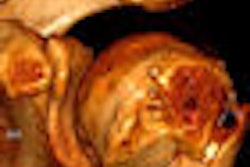CHICAGO - Brazilian researchers say that perfusion MRI with a dynamic susceptibility contrast-enhanced technique may allow doctors to determine the best ways of treating patients with brain malignancies, according to a presentation on Sunday at this week's RSNA conference.
One way is to use MRI to determine reperfusion patterns that indicate how well a tumor is oxygenated, building on knowledge that well-oxygenated tumors respond better to therapies such as radiation, whereas hypoxic tumors fail to respond as well to treatment.
In one study, Dr. Augusto Mamere of Barretos Cancer Hospital in Brazil and colleagues calculated pretherapeutic relative cerebral blood volume and relative cerebral blood flow in the area around the tumor.
Among the 25 patients with a variety of lung cancer metastases, tumors that appeared to be highly oxygenated responded better to treatment than hypoxic tumors, he said in his presentation.
In reviewing outcomes, the researchers identified 14 patients who responded to treatment and 11 patients who did not respond, according to standard criteria. The group selected one measurable nodule -- at least 10 mm in size -- for follow-up studies. All the patients received standard 30-Gy whole-brain radiation therapy for metastases.
Mamere and colleagues measured tumor size post-treatment and compared it to baseline MR scans acquired within a week of initial therapy. The follow-up scans were performed one and three months after the end of therapy. "Tumor oxygenation is directly related to vessel density inside the tumor," he noted.
The researchers employed perfusion MRI using dynamic susceptibility contrast-enhanced techniques to estimate brain tumor microvessel density. The mean value of blood volume among those with tumors that responded to radiotherapy was 6.33, compared to a mean value of 3.03 among those whose tumors did not show favorable changes, Mamere said. That difference, he noted, reached statistical significance (p < 0.05)
Similarly, the mean value of blood flow in the tumor was 5.24 among patients judged to be responders, compared with 2.77 among those who did not respond (p < 0.05).
"These preliminary data provide evidence that pretreatment perfusion MRI with relative cerebral blood volume and relative cerebral blood flow measurement may potentially predict brain metastases' response to palliative whole-brain radiation therapy," he said.
While Mamere's study is preliminary, Dr. Zoran Rumboldt, chief of the neuroradiology section at the Medical University of South Carolina in Charleston, a co-moderator of the presentation sessions, said, "This information can be helpful in differentiating treatment for patients. If you know that they are not going to do well with radiation, you can utilize other options such as a chemotherapy or surgery where possible."
Co-moderator Dr. Edmond Knopp, associate professor of radiology and neurosurgery at the New York University School of Medicine, said that Mamere's study, as well as others in the session, indicate that the imaging technology may offer pretreatment options for patients, but "the numbers of patients in these studies is small. We need larger patient populations before these technologies can be routinely used."
By Edward Susman
AuntMinnie.com contributing writer
November 29, 2009
Copyright © 2009 AuntMinnie.com



















